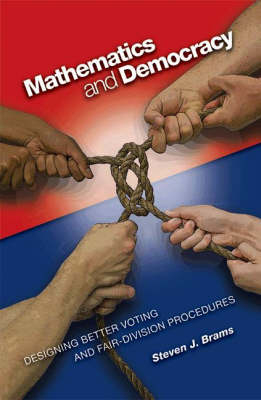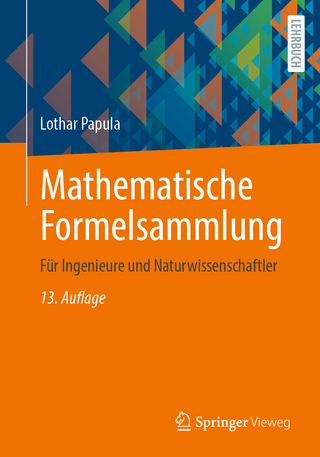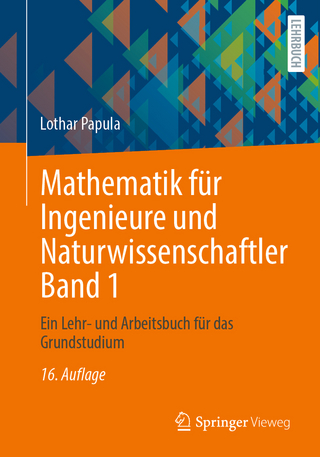
Mathematics and Democracy
Princeton University Press (Verlag)
978-0-691-13320-1 (ISBN)
- Titel ist leider vergriffen;
keine Neuauflage - Artikel merken
Voters today often desert a preferred candidate for a more viable second choice to avoid wasting their vote. Likewise, parties to a dispute often find themselves unable to agree on a fair division of contested goods. In "Mathematics and Democracy", Steven Brams, a leading authority in the use of mathematics to design decision-making processes, shows how social-choice and game theory could make political and social institutions more democratic. Using mathematical analysis, he develops rigorous new procedures that enable voters to better express themselves and that allow disputants to divide goods more fairly. One of the procedures that Brams proposes is "approval voting," which allows voters to vote for as many candidates as they like or consider acceptable. There is no ranking, and the candidate with the most votes wins. The voter no longer has to consider whether a vote for a preferred but less popular candidate might be wasted. In the same vein, Brams puts forward new, more equitable procedures for resolving disputes over divisible and indivisible goods.
Steven J. Brams is professor of politics at New York University. He is the author of "Theory of Move"s, among many other books, and the coauthor of "The Win-Win Solution: Guaranteeing Fair Shares to Everybody" and "Fair Division: From Cake-Cutting to Dispute Resolution".
Preface xiii PART 1. VOTING PROCEDURES 1 Chapter 1: Electing a Single Winner: Approval Voting in Practice 3 1.1. Introduction 3 1.2. Background 6 1.3. Early History 8 1.4. The Adoption Decisions in the Societies 10 1.5. Does AV Make a Difference? 14 1.6. Does AV Elect the Lowest Common Denominator? 16 1.7. Is Voting Ideological? 18 1.8. Summary and Conclusions 21 Chapter 2: Electing a Single Winner: Approval Voting in Theory 23 2.1. Introduction 23 2.2. Preferences and Strategies under AV 25 2.3. Election Outcomes under AV and Other Voting Systems 26 2.4. Stability of Election Outcomes 37 2.5. Summary and Conclusions 42 Appendix 43 Chapter 3: Electing a Single Winner: Combining Approval and Preference 46 3.1. Introduction 46 3.2. Definitions and Assumptions 48 3.3. Preference Approval Voting (PAV) 49 3.4. Fallback Voting (FV) 52 3.5. Monotonicity of PAV and FV 56 3.6. Nash Equilibria under PAV and FV 58 3.7. The Effects of Polls in 3-Candidate Elections 61 3.8. Summary and Conclusions 66 Chapter 4: Electing Multiple Winners: Constrained Approval Voting 69 4.1. Introduction 69 4.2. Background 70 4.3. Controlled Roundings 72 4.4. Further Narrowing: The Search May Be Futile 75 4.5. Constrained Approval Voting (CAV) 80 4.6. Unconstraining Votes: Two Alternatives to CAV 82 4.7. Summary and Conclusions 87 Chapter 5: Electing Multiple Winners: The Minimax Procedure 89 5.1. Introduction 89 5.2. Minisum and Minimax Outcomes 91 5.3. Minimax versus Minisum Outcomes: They May Be Antipodes 97 5.4. Endogenous versus Restricted Outcomes 101 5.5. Manipulability 103 5.6. The Game Theory Society Election 105 5.7. Summary and Conclusions 108 Appendix 109 Chapter 6: Electing Multiple Winners: Minimizing Misrepresentation 112 6.1. Introduction 112 6.2. Obstacles to the Implementation of Proportional Representation (PR) 113 6.3. Integer Programming 115 6.4. Monroe's System 116 6.5. Assigning More than One Candidate to a Voter 119 6.6. Approval Voting 121 6.7. Fractional Assignments 123 6.8. Noninteger k 125 6.9. The Chamberlin-Courant System 126 6.10. Tullock's System 127 6.11. Weighted Voting 129 6.12. Nonmanipulability 130 6.13. Representativeness 131 6.14. Hierarchical PR 133 6.15. Summary and Conclusions 136 Appendixes 138 Chapter 7: Selecting Winners in Multiple Elections 143 7.1. Introduction 143 7.2. Referendum Voting: An Illustration of the Paradox of Multiple Elections 145 7.3. The Coherence of Support for Winning Combinations 149 7.4. Empirical Cases 155 7.5. Relationship to the Condorcet Paradox 160 7.6. Normative Questions and Democratic Political Theory 165 7.7. Yes-No Voting 167 7.8. Summary and Conclusions 169 PART 2. FAIR-DIVISION PROCEDURES 171 Chapter 8: Selecting a Governing Coalition in a Parliament 173 8.1. Introduction 173 8.2. Notation and Definitions 176 8.3. The Fallback (FB) and Build-Up (BU) Processes 177 8.4. The Manipulability of FB and BU 181 8.5. Properties of Stable Coalitions 182 8.6. The Probability of Stable Coalitions 186 8.7. The Formation of Majorities in the U.S. Supreme Court 189 8.8. Summary and Conclusions 193 Appendix 195 Chapter 9: Allocating Cabinet Ministries in a Parliament 199 9.1. Introduction 199 9.2. Apportionment Methods and Sequencing 202 9.3. Sophisticated Choices 206 9.4. The Twin Problems of Nonmonotonicity and Pareto-Nonoptimality 209 9.5. Possible Solutions: Trading and Different Sequencing 214 9.6. A 2-Party Mechanism 215 9.7. Order of Choice and Equitability 218 9.8. Summary and Conclusions 220 Appendix 221 Chapter 10: Allocating Indivisible Goods: Help the Worst-Off or Avoid Envy? 224 10.1. Introduction 224 10.2. Maximin and Borda Maximin Allocations 227 10.3. Characterization of Efficient Allocations 229 10.4. Maximin and Borda Maximin Allocations May Be Envy-Ensuring 234 10.5. Finding Envy-Unensuring Allocations 244 10.6. Unequal Allocations and Statistics 248 10.7. Summary and Conclusions 250 Chapter 11: Allocating a Single Homogeneous Divisible Good: Divide-the-Dollar 252 11.1. Introduction 252 11.2. DD1: A Reasonable Payoff Scheme 254 11.3. DD2: Adding a Second Stage 257 11.4. DD3: Combining DD1 and DD2 262 11.5. The Solutions with Entitlements 263 11.6. Summary and Conclusions 266 Appendix 267 Chapter 12: Allocating Multiple Homogeneous Divisible Goods: Adjusted Winner 271 12.1. Introduction 271 12.2. Proportionality, Envy-Freeness, and Efficiency 272 12.3. Adjusted Winner (AW) 273 12.4. Issues at Camp David 275 12.5. The AW Solution 279 12.6. Practical Considerations 282 12.7. Summary and Conclusions 287 Chapter 13: Allocating a Single Heterogeneous Good: Cutting a Cake 289 13.1. Introduction 289 13.2. Cut-and-Choose: An Example 290 13.3. The Surplus Procedure (SP) 292 13.4. Three or More Players: Equitability and Envy-Freeness May Be Incompatible 296 13.5. The Squeezing Procedure 297 13.6. The Equitability Procedure (EP) 299 13.7. Summary and Conclusions 303 Chapter 14: Allocating Divisible and Indivisible Goods 305 14.1. Introduction 305 14.2. Definitions and Assumptions 306 14.3. Difficulties with Equal and Proportional Reductions in the High Bids 308 14.4. The Gap Procedure 312 14.5. Pareto-Optimality 314 14.6. Envy-Freeness: An Impossible Dream 316 14.7. Sincerity and In dependence 322 14.8. Extending the Gap Procedure 323 14.9. Other Applications 324 14.10. Summary and Conclusions 327 Chapter 15: Summary and Conclusions 329 Glossary 337 References 343 Index 363
| Erscheint lt. Verlag | 15.1.2008 |
|---|---|
| Zusatzinfo | 2 line illus. 19 tables. |
| Verlagsort | New Jersey |
| Sprache | englisch |
| Maße | 152 x 235 mm |
| Gewicht | 652 g |
| Themenwelt | Mathematik / Informatik ► Mathematik ► Angewandte Mathematik |
| Mathematik / Informatik ► Mathematik ► Finanz- / Wirtschaftsmathematik | |
| Sozialwissenschaften ► Politik / Verwaltung ► Staat / Verwaltung | |
| ISBN-10 | 0-691-13320-4 / 0691133204 |
| ISBN-13 | 978-0-691-13320-1 / 9780691133201 |
| Zustand | Neuware |
| Informationen gemäß Produktsicherheitsverordnung (GPSR) | |
| Haben Sie eine Frage zum Produkt? |
aus dem Bereich


